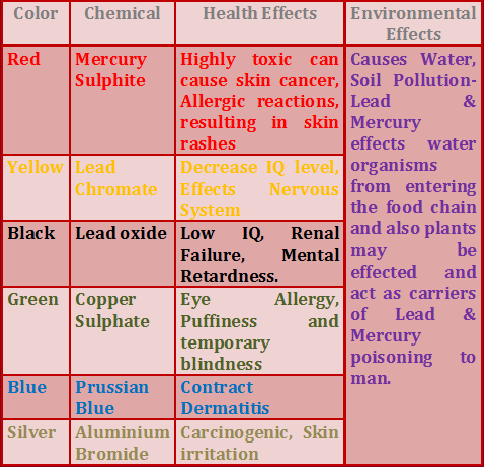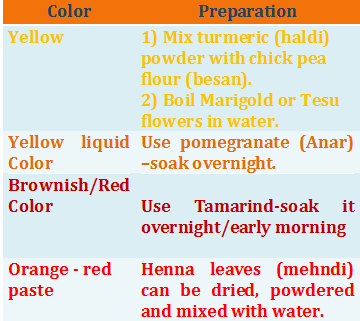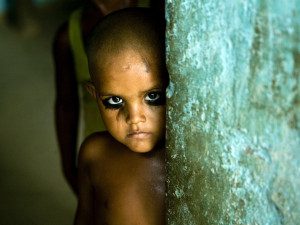
How to celebrate Eco-friendly Holi
In an ideal world, the joyous festival of Holi is meant to celebrate the arrival of Spring while the colours used in Holi are to reflect of the various hues of spring season. But unfortunately, in modern times Holi does not stand for all things beautiful. Like various other festivals, Holi too has become ruthlessly commercialized, boisterous and yet another source of environmental degradation and health problem. Hence many consumers are on the look out for Holi Colours made from natural materials and safe for health and environment.
Toxic Elements/Chemical in Holi Colours
According to many research and previous studies related to Holi colour products, the pastes contain very toxic chemicals/elements that can have severe health effects.You can also get tested your holi colour products at NRCLPI ( National Referral Centre for Lead Projects in India) , St John’s Medical College, Kormanagala , Bengaluru.
Few examples of colour and the chemical content with their few health effects on human and environment:

Harmful Chemicals in Gulal & Harms of Wet Holi Colours
The dry colours, commonly known as gulals, have two components a colorant that is toxic and a base which could be either asbestos or silica, both of which cause health problems. Heavy metals contained in the colorants can cause asthma, skin diseases and adversely affect the eyes.
Wet colours, mostly use Gentian violet as a colour concentrate which can cause skin discoloration and dermatitis.
These days, Holi colours sell loose, in the market and traders are also unaware about the source of the holi colour products as it comes from a group of networked people/sellers exchanging hand to hand from different parts of the country. In few instants, the colours come wrapped that specifically say for industrial purpose/use or without any origin/manufacture details.
Make your own Eco-friendly Holi colours
Holi festival lovers will be thrilled to know that it is possible to make simple, natural colours in one’s own home. Here are some very simple recipes to make natural colours:

Safeguarding Water
Just on 22 March we all observed World Water Day, across the Globe. In the current scenario, when India and the rest of the world is facing acute water shortage, the water wastage in the name of Holi in the extreme, is also being unjusticable. It is usual or general using buckets of water during Holi but please keep in mind that you are not only wasting water resource, but also polluting it with harmful and toxic chemicals. If a single person uses 2 liter of water on Holi on splashing/playing just imagine the number of liters of water used across India with a billion+ population .
So, make sure we don’t waste and pollute water, which is most needed for our coming generations too.
Tips to celebrate a safe Holi
- Use homemade natural and safe colours-Learn the art of preparing the colours yourself and enjoy teaching your younger’s and your neighbors too.
- Use natural, skin-friendly and herbal colours are the ones made by reputed companies using natural products.
- If you opt to buy/purchase colours, commercially be sure to purchase naturally made products from reputed companies also ensure about the source.
- Apply a nice layer of oil to your hair before playing Holi so that residue from the dyes does not get stuck to your hair and scalp.
- Ensure that your eyes remain protected at all times. Wash with plenty of clean water should any colour get into your eyes accidentally. See a doctor if the irritation still persists.
- If you are playing Holi, apply a thick layer of coconut or any oil on your body and hair until they glisten and you become slippery.
- Wear dental caps if possible to protect your teeth.
- Avoid flashing on the face and as well protect your face from the Holi colours.
- Wear clothes at the maximum to cover your body.
- Apply an oil/cream of good quality to protect your skin.
Traditional Background
[plain]The Holi is an ancient Indian festival of colours symbolizing signs of happiness, joy and growth engaging all ages of people. The celebrations in India cut across section and religious conviction. This festival, now also draws a world attention and many countries are also celebrating the festival of colours and enjoying with sharing of sweets.., love.., peace and brotherly hood.
Holi is celebrated with enthusiasm and gaiety on the full moon day in the month of Phalgun which is the month of March as per the Gregorian calendar. Holi festival may be celebrated known by different names among people of various states and would be following different rituals & traditions. But, what makes Holi so unique and special is the spirit and enthusiasm of it which remains the same throughout the country and even across the globe, wherever it is celebrated.
This festival celebrates the arrival of spring on Fagun Sud Purnima. Also known as Falgunika, people celebrate the changing season and the beauty associated with spring blossoms by spraying colour.
In the Gita (10/35), Shri Krishna proclaims spring as the foremost season and one of his Vibhutis -forms: Rutunaam kusumaakaraha
The ritual of offering roasted grain to Agni – fire-deity is known as Navaanineshti. In Sanskrit, roasted grain is Holaakaa, from which the Hindi ‘Holi’ is derived. Since Vedic times people availed the newly harvested grain only after offering to the devas. This offering of new grain is Holi.
The Bhavishyottara Puran associates Holi both with man and Yagna. Therefore the Yagna performed for man’s salvation is Holi.[/plain]
[plain]About the Author:
 Vinay Kumar. C is an Environmental Researcher at NRCLPI – The National Referral Centre for Lead Poisoning in India. He is a multi-skilled professional having an excellent track record of managing complex functional projects in various environments. [/plain]
Vinay Kumar. C is an Environmental Researcher at NRCLPI – The National Referral Centre for Lead Poisoning in India. He is a multi-skilled professional having an excellent track record of managing complex functional projects in various environments. [/plain]
DISCLAIMER : Views expressed above are the author’s own.



Hi lifestyletodaynews.com owner, Your posts are always well-balanced and objective.
Hi lifestyletodaynews.com owner, Thanks for the well-structured and well-presented post!
Hi lifestyletodaynews.com owner, Thanks for the detailed post!
To the lifestyletodaynews.com administrator, Thanks for the well-researched and well-written post!
To the lifestyletodaynews.com admin, You always provide key takeaways and summaries.
Hi lifestyletodaynews.com owner, You always provide great examples and case studies.
Dear lifestyletodaynews.com webmaster, Your posts are always well-referenced and credible.
Hi lifestyletodaynews.com admin, Your posts are always insightful and valuable.
Dear lifestyletodaynews.com owner, Thanks for the well-structured and well-presented post!
Hello lifestyletodaynews.com owner, You always provide valuable feedback and suggestions.
Dear lifestyletodaynews.com admin, Thanks for the informative post!
Hello lifestyletodaynews.com admin, Your posts are always insightful and valuable.
Hi lifestyletodaynews.com admin, Your posts are always a great source of knowledge.
Hi lifestyletodaynews.com administrator, You always provide helpful diagrams and illustrations.
To the lifestyletodaynews.com administrator, You always provide helpful information.
To the lifestyletodaynews.com webmaster, Keep up the great work!
To the lifestyletodaynews.com admin, You always provide in-depth analysis and understanding.
Hello lifestyletodaynews.com administrator, Your posts are always well received by the community.
To the lifestyletodaynews.com administrator, Thanks for the comprehensive post!
Hello lifestyletodaynews.com owner, You always provide helpful diagrams and illustrations.
Dear lifestyletodaynews.com webmaster, You always provide useful links and resources.
Hello lifestyletodaynews.com owner, Your posts are always well-timed and relevant.
To the lifestyletodaynews.com administrator, You always provide in-depth analysis and understanding.
To the lifestyletodaynews.com administrator, You always provide great examples and real-world applications, thank you for your valuable contributions.
Hi lifestyletodaynews.com administrator, Thanks for the detailed post!
Hello lifestyletodaynews.com webmaster, Your posts are always well-received and appreciated.
To the lifestyletodaynews.com owner, Thanks for the in-depth post!
To the lifestyletodaynews.com owner, You always provide clear explanations and step-by-step instructions.
To the lifestyletodaynews.com owner, You always provide great insights.